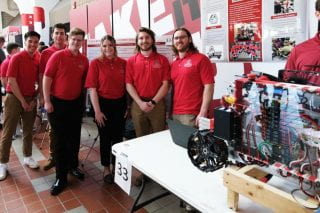CSCE Capstone
Student Site for Individual and Collaborative Activites
Team 5 – NASA Robotic Mining Competition with Arkansas Razorbotz
Team Members:
AnElizabeth Henry Tristen Teague
Description:
The National Aeronautics and Space Administration (NASA for short) has established themselves as a worldwide force in space exploration since it was established in 1958. As a part of their research in space exploration, NASA has planned many goals for the future of space exploration. One of the goals includes investing in the future generations’ technologies and inspiring current students to pursue career paths in STEM related fields through interactions with space program [1]. Another one of the goals that NASA has planned is a mission to put a woman and a person of color on the moon for the first time ever and use more innovative and advanced technologies to explore the lunar surface in hopes to begin to establish a permeant presence of life on the moon [2]. This mission is known as the Artemis mission. At the intersection of these two plans that NASA has for the future we can find a creative competition known as NASA’s Lunabotics Competition.
NASA’s Lunabotics Competition (called NASA’s Robotics Mining Competition in previous years) is a university level competition established in 2010 where teams that are comprised of at least two undergraduate students and a working robot will compete to demonstrate full operation and capability of the robot and its’s ability to maneuver through a simulated environment and mine rock/gravel material [3]. The purpose of the robot for each team in the competition is to be capable of navigating, mining, and extracting resources from an area that is simulated as the surface of the moon. In such a simulated environment, the robot will have to navigate around obstacles, mine materials, collect the materials, and then return to a specific navigation site to dump the materials off for collection. The competition is designed to allow teams from universities across the country to “use the NASA Systems Engineering Process to design, build, and operate a lunar robot” and to “also perform public outreach, submit systems engineering papers and present and demonstrate their work to a NASA review panel.” [3] To compete in the competition, the University of Arkansas has entered the competition with their very own team: The Razorbotz. The Razorbotz team is comprised of many sub-teams that each work on different aspects of the robot to produce the overall final design. Some examples of the sub-teams are: Electrical, Excavation, Chassis, and Computer Science. During this semester, Capstone group 5 will be joining the Computer Science sub-team to help implement the computer systems of the robot. As a result of joining the team, our capstone group will be afforded the knowledge of working through the systems engineering process and the challenges associated with it to design a complex machine. As a result of our hard work, we can put forward the knowledge that we gained through the process so that NASA may see our work and possibly use our technologies for the future of space exploration.
Contact:
Uche Wejinya, uwejinya@uark.edu
References:
[1] “National Aeronautics and Space Administration (NASA).” Performance.gov, url: https://obamaadministration.archives.performance.gov/agency/national-aeronautics-and-space-administration.html.
[2] “Artemis.” NASA, NASA, url: https://www.nasa.gov/specials/artemis/.
[3] Hall, Loura. “Lunabotics.” NASA, NASA, 30 Sept. 2021, https://www.nasa.gov/solve/LUNABOTICS/.
Meta
Links
Project Proposal
Final Project Report
Poster
Deliverables
- Razorbotz GitHub Code
- Razorbotz Documentation
- Razorbotz Systems Engineering Report
- Razorbotz 2022 Demo Video
Attendance Records
Task
- Trello task board created by another Razorbotz member William Burroughs to keep all CSCE members on the same page even those who are not on the capstone team.
